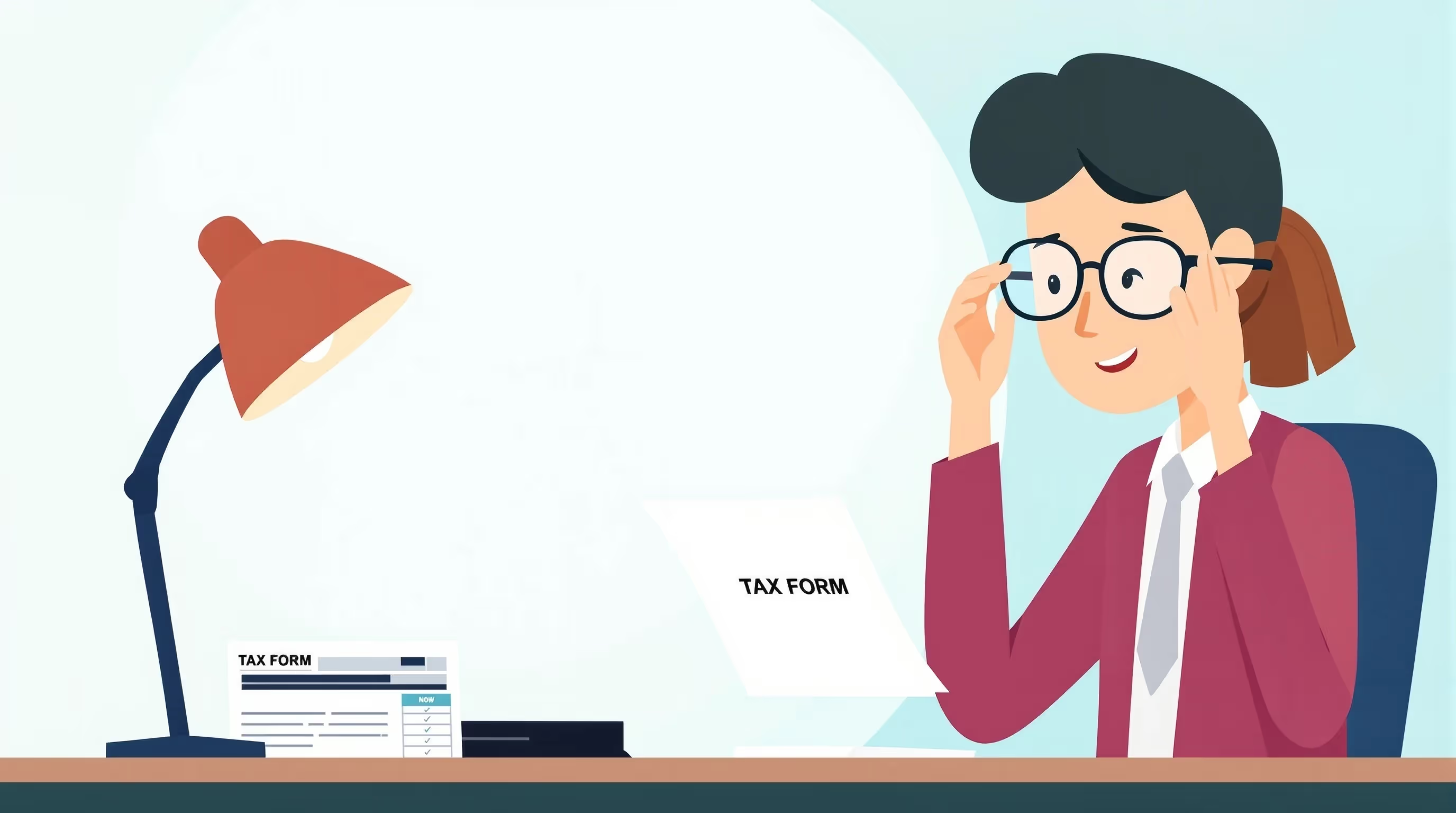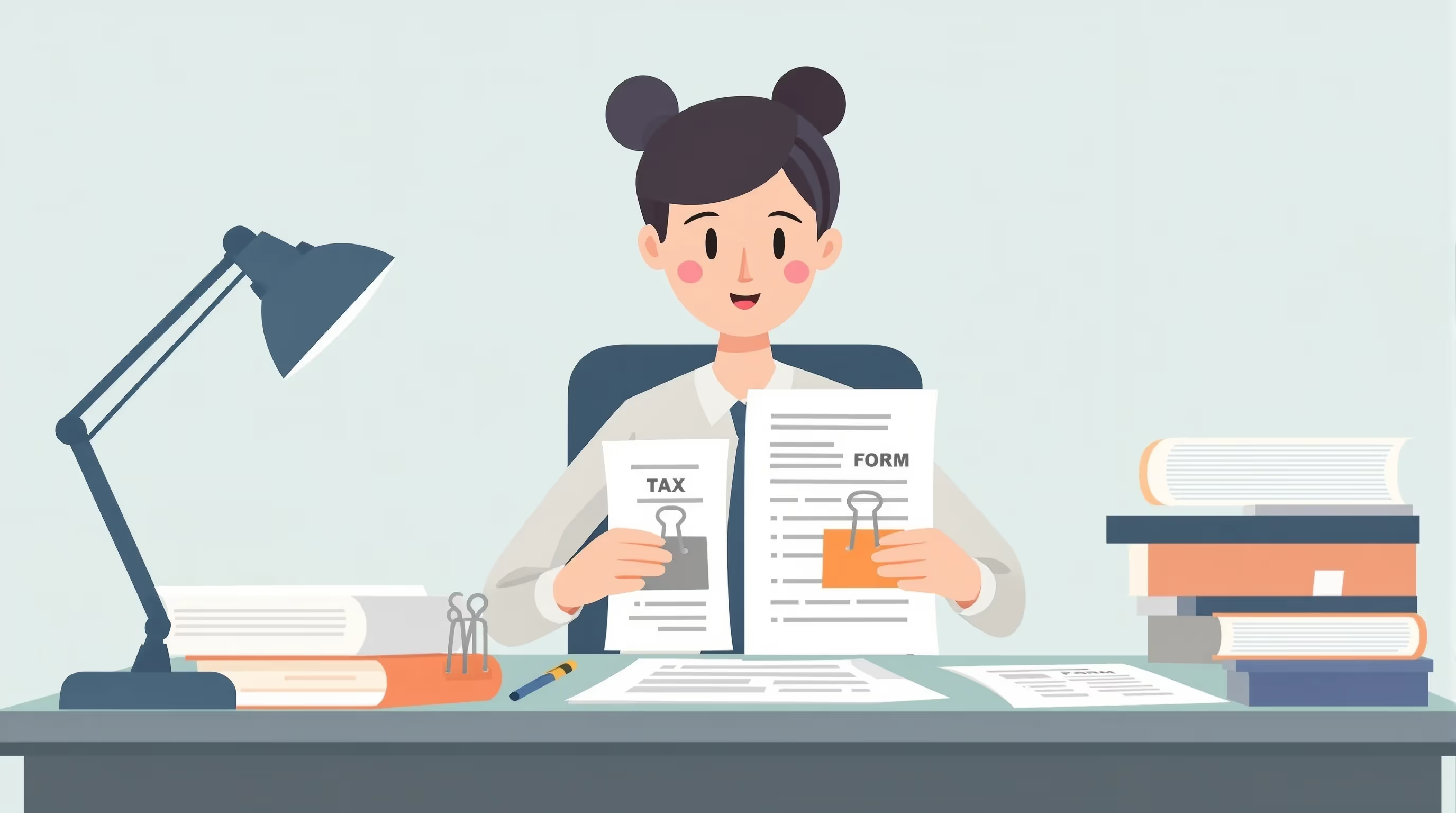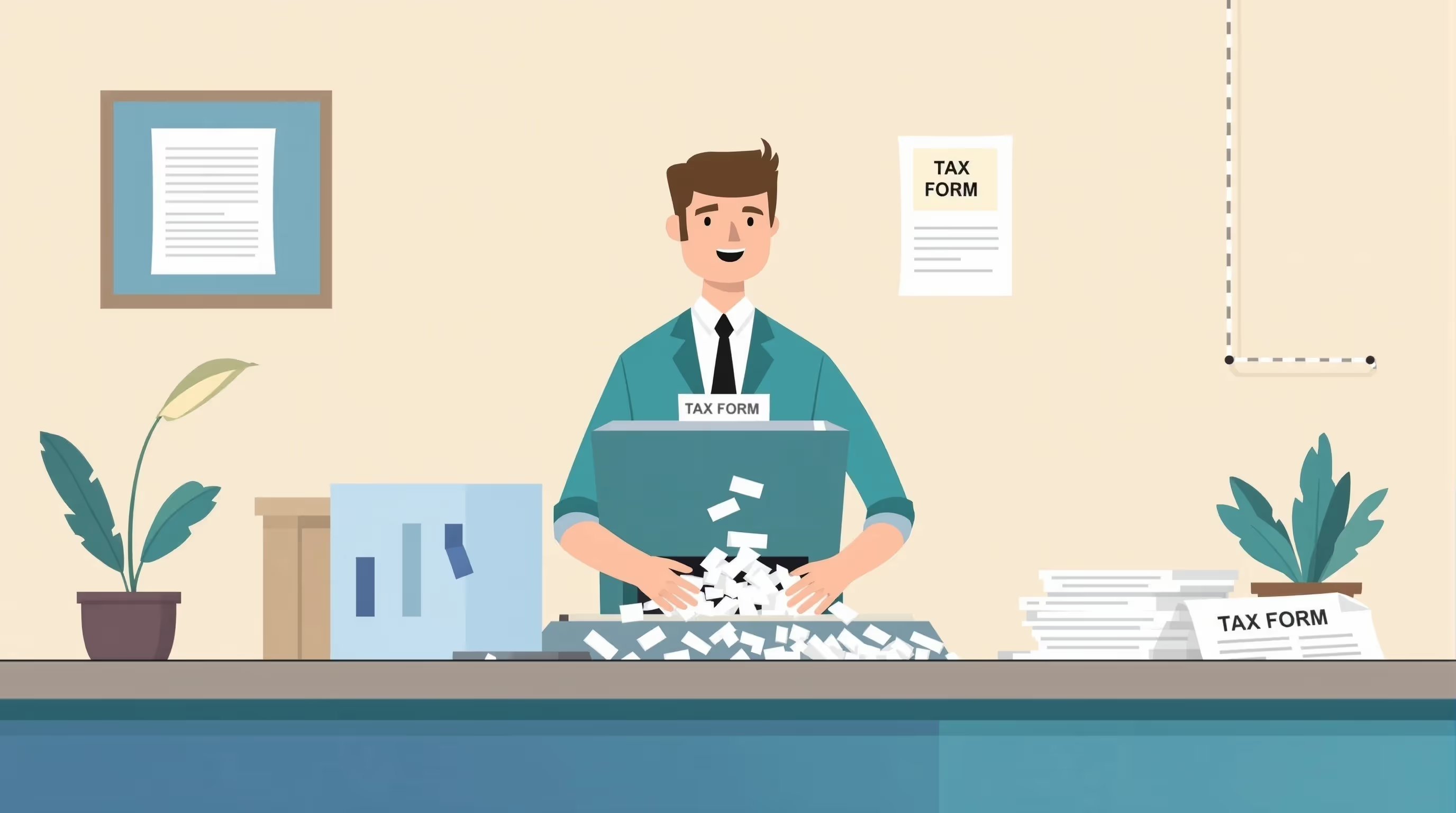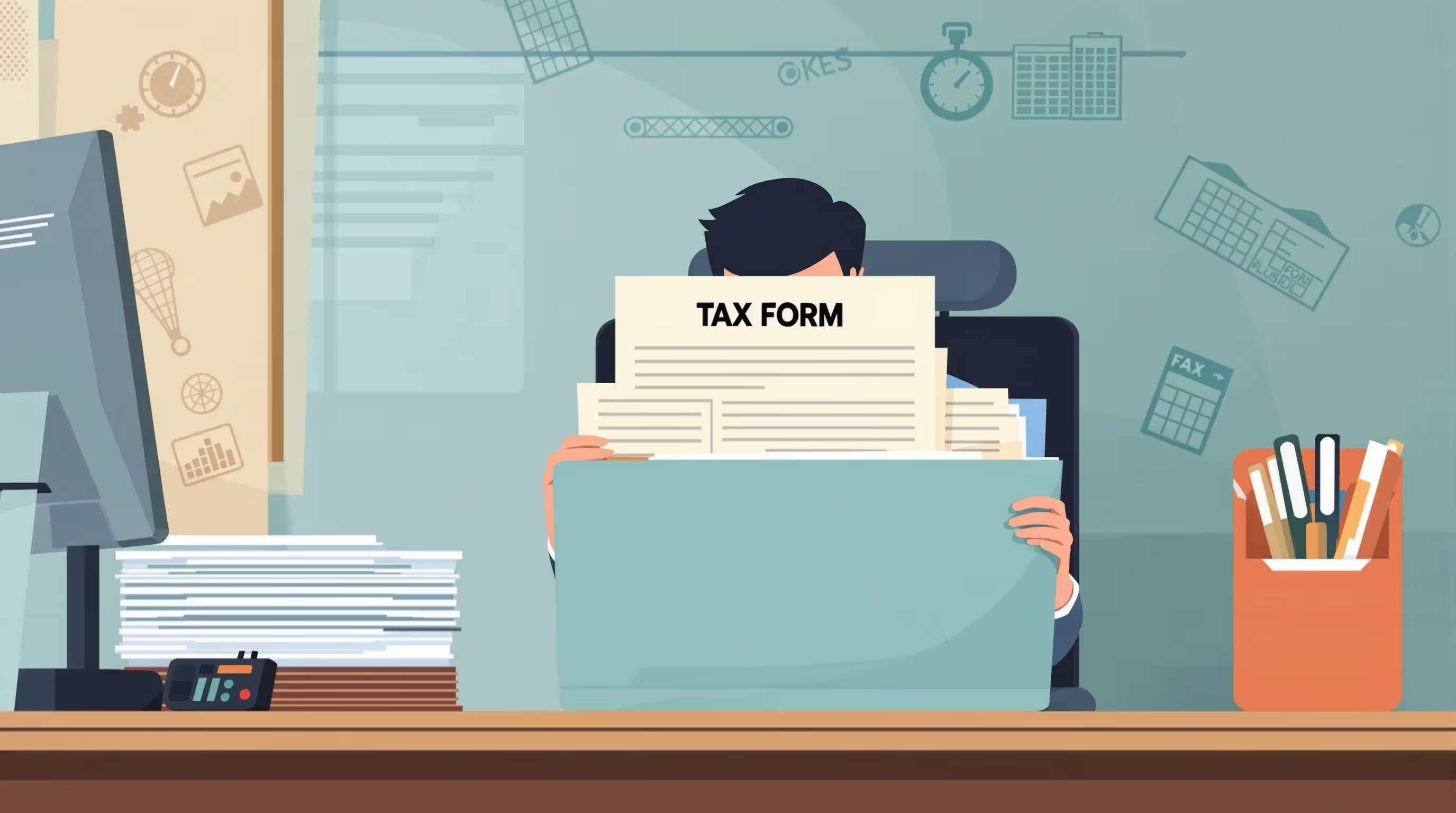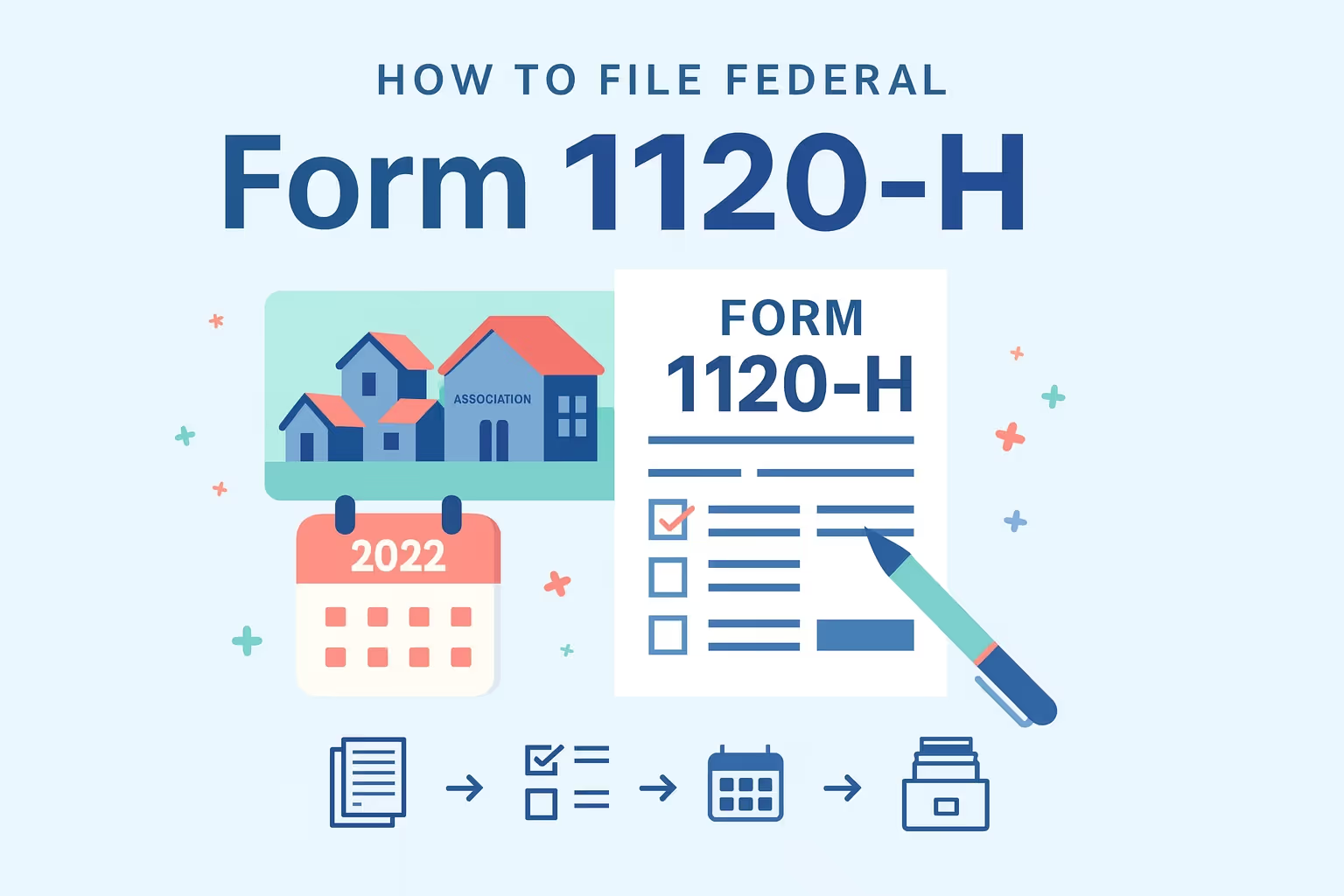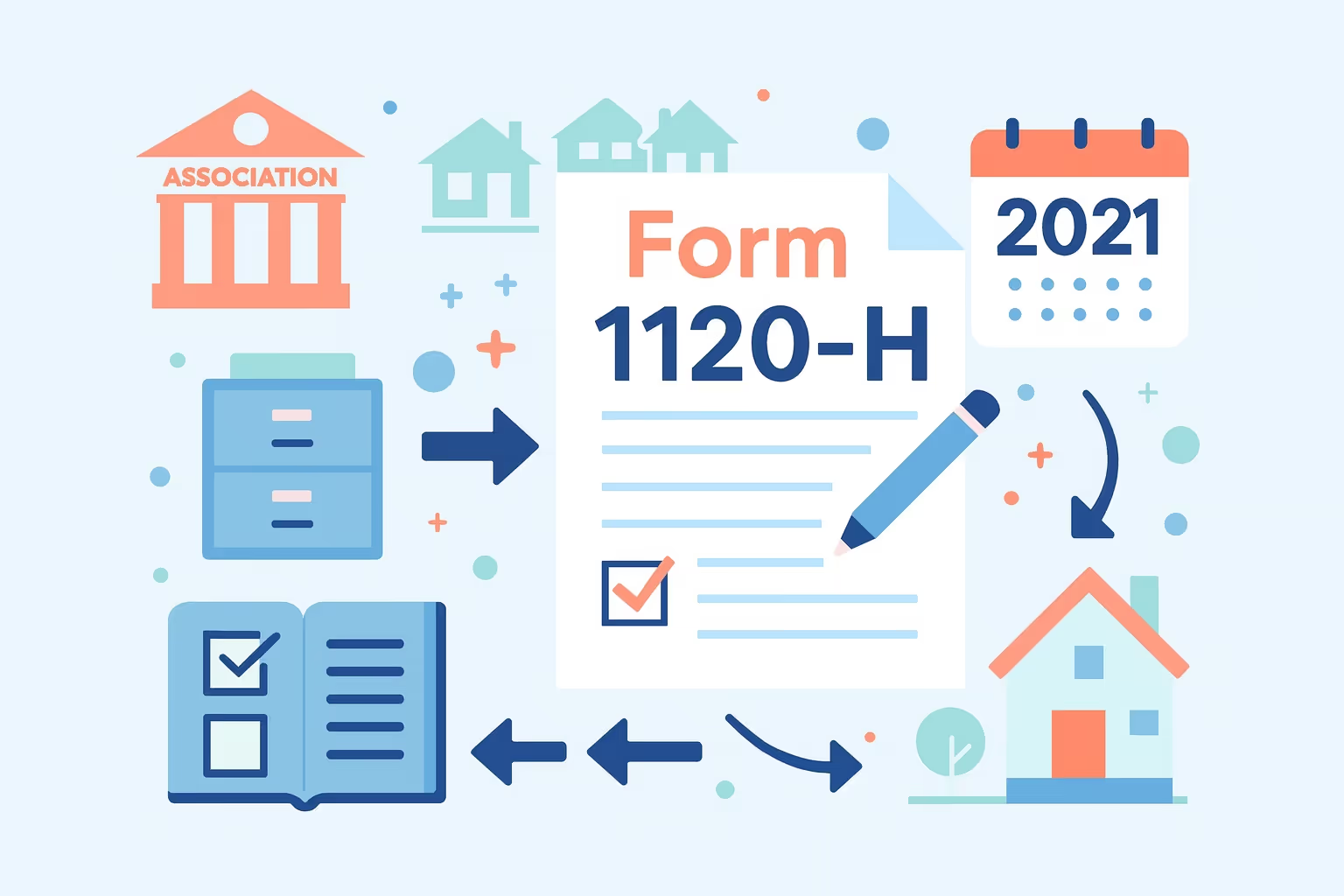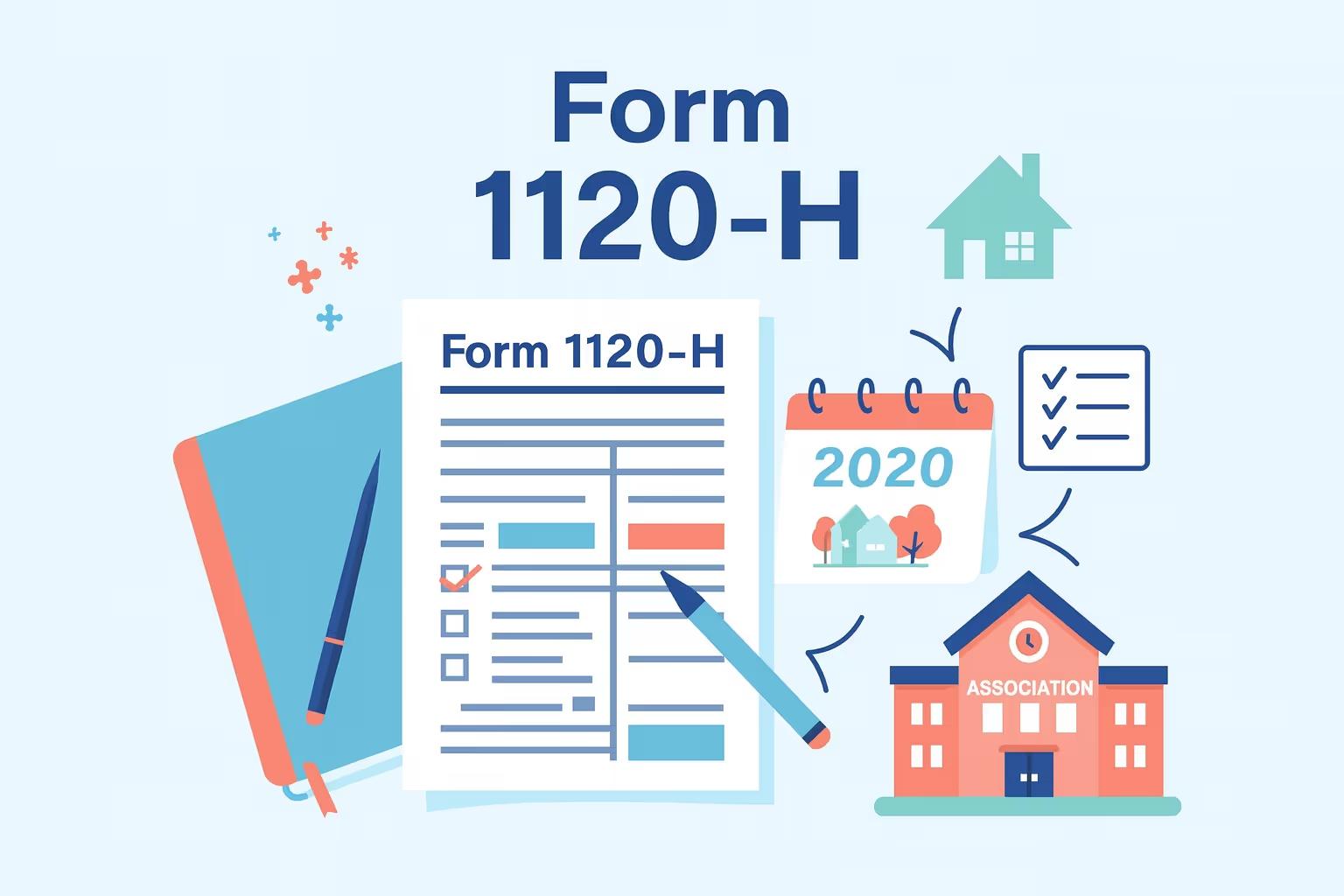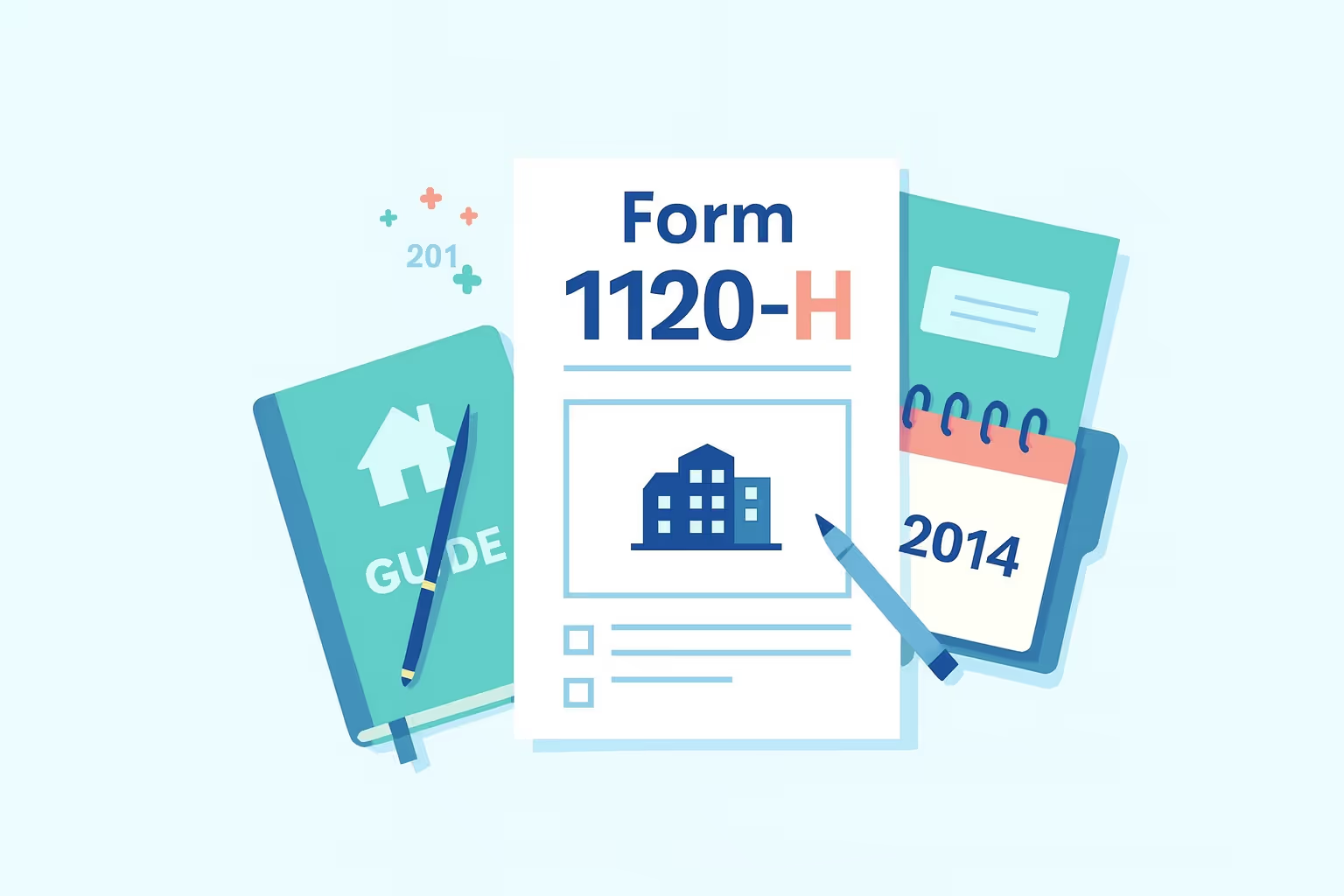How to File Federal Form 1120-H for Tax Year 2023 (HOAS)
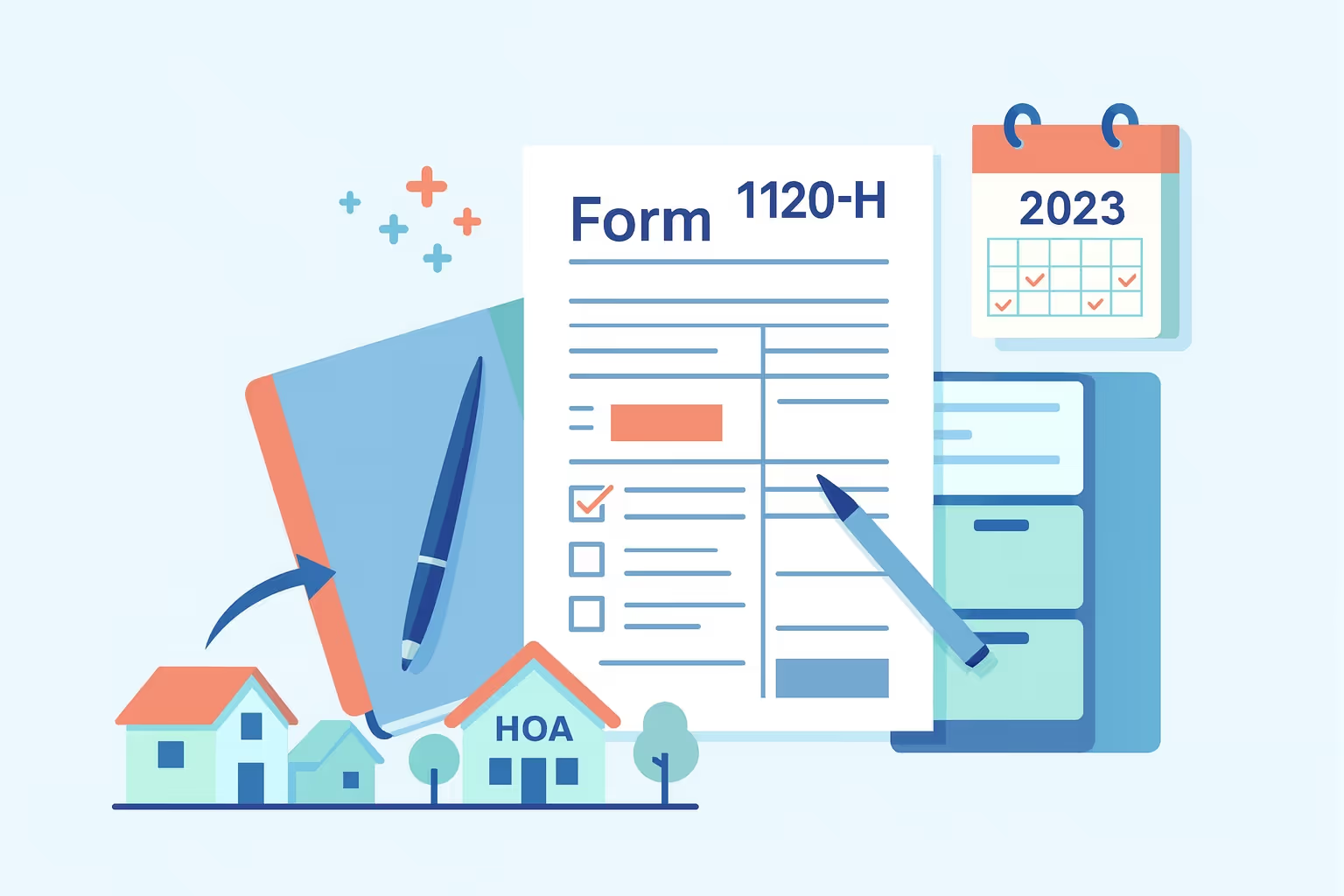
Thousands of homeowner associations face IRS yearly scrutiny because of income tax return errors. According to IRS data, late or incorrect filings can trigger penalties of 5 percent of unpaid tax per month, up to a maximum of 25 percent. These mistakes can easily cost hundreds or even thousands of dollars for an association managing a large budget.
Federal Form 1120-H for Tax Year 2023 for HOAs provides a critical option for condominium management associations, residential real estate associations, and timeshare associations to simplify their tax obligations. By using this form, qualifying organizations can exclude exempt function income from gross income, claim certain tax benefits, and calculate taxable income more efficiently. Filing correctly preserves tax benefits, lowers audit risk, and prevents unnecessary financial strain.
This guide will walk you through filing Federal Form 1120-H for Tax Year 2023 for HOAs. You will learn who qualifies, what has changed for this tax year, and the steps required to complete the form accurately. You will also see how filing early, filing electronically, and avoiding common errors can protect your association from costly mistakes and ensure compliance with IRS regulations.
Understanding Federal Form 1120-H for Tax Year 2023
Federal Form 1120-H is the U.S. Income Tax Return for Homeowners Associations. It was created under Internal Revenue Code Section 528 to give specific tax benefits to qualified associations. The form simplifies the filing process by allowing associations to exclude exempt function income, such as membership dues and assessments, from their gross income. Instead of calculating complex corporate tax rates, associations can apply a flat tax rate once non-exempt income is determined.
This form is distinct from Form 1120, the standard corporation income tax return. Many associations file Form 1120-H because it reduces administrative burden, but in some cases, Form 1120 may result in lower tax liability.
Comparison 1: 1120-H vs Form 1120 Filing
Form 1120-H
- Eligibility: Only available to homeowners’ associations (HOAs).
- Tax Rate: 30% for residential/condo associations, 32% for timeshare associations.
- Income Excluded: Exempt function income is not taxed.
- Complexity: Simplified filing with fewer requirements.
- Flexibility: Can be elected annually if the HOA qualifies.
Form 1120
- Eligibility: Required for all corporations not eligible to file Form 1120-H.
- Tax Rate: Uses the standard corporate tax rate (currently 21%).
- Income Excluded: No exclusions—exempt function income is fully taxable.
- Complexity: More complex filing with detailed schedules.
- Flexibility: Mandatory for corporations and HOAs that do not qualify for 1120-H election.
Who Can File Form 1120-H?
The following organizations may elect to file Form 1120-H if they meet IRS requirements:
- Condominium management associations are organized to manage property where substantially all units are individual homes.
- Residential real estate associations include subdivisions, planned communities, or similar developments that maintain shared or common areas for the benefit of members.
- Timeshare associations are groups that manage property for timeshare owners, as long as they are not classified as condominium management associations.
Key Tax Benefits Under Section 528
Filing Federal Form 1120-H for Tax Year 2023 for HOAs offers significant advantages:
- Associations may exclude exempt function income, which includes membership dues, assessments, and homeowner fees. This ensures that taxable income accurately reflects only non-exempt income.
- Every qualifying association automatically receives a $100 deduction, reducing reported taxable income.
- Flat tax rates simplify planning and reduce administrative costs.
- Filing helps preserve the HOA’s right to special tax treatment yearly, as the election must be renewed annually.
What Changed for Tax Year 2023
For tax year 2023, penalties for late filing have increased. If a homeowners association files its return more than 60 days after the deadline, the minimum penalty is the lesser of the unpaid tax or $485. This higher penalty makes timely filing essential, even for associations that owe little or no federal tax. Missing the deadline could cost your HOA hundreds of dollars unnecessarily.
Another significant change is the e-filing requirement. Any association that files 10 or more returns during the calendar year must now file Form 1120-H electronically. This replaces the old threshold of 250 returns, meaning many more minor associations that previously filed on paper must now adjust to the IRS electronic system.
New Credit Election Rules
The IRS also introduced elective payment rules. Certain tax credits, including the qualified electric vehicle, low-income housing, and new markets credit, may now be treated as elective payments. In some cases, this can result in direct refunds instead of reducing tax liability only. Associations should review the instructions for Form 3800 and line 23f of Form 1120-H to see if they qualify.
Why Staying Updated Matters
Tax law changes can affect whether an association owes tax, how credits are applied, and whether penalties apply. Relying on outdated filing rules is one of the most common mistakes homeowners' associations make. Reviewing current IRS regulations, checking the IRS website regularly, and consulting a tax professional can prevent errors and ensure your association remains compliant.
Step-by-Step Filing Instructions
Filing Federal Form 1120-H for Tax Year 2023 for HOAs may seem complex initially, but breaking it into manageable steps ensures accuracy and helps homeowners' associations avoid costly errors. Following a structured process will also make it easier to confirm eligibility, calculate taxable income accurately, and report income in compliance with IRS regulations.
Step 1: Gather Required Information
Before completing the form, assemble the necessary documents and records.
- The Employer Identification Number (EIN) is required, so verify that the association has an active number issued by the IRS.
- Collect financial records for the tax year, including bank accounts, membership dues, gross receipts, and statements showing income tax withheld or federal tax paid.
- Separate exempt function income from non-exempt income. Exempt function income includes member dues, assessments, and association services fees. Non-exempt income includes interest, rental payments from non-members, or capital gains.
Step 2: Complete Association Details
At the top of Form 1120-H, enter the association’s legal name, mailing address, and EIN. Indicate the type of association by checking the appropriate box for condominium management, residential real estate, or timeshare associations.
- Ensure that the EIN is listed correctly. An incorrect or missing EIN is one of the most common filing errors.
- Check the corresponding box if the homeowners' association files an amended or final return or reports a name or address change.
Step 3: Apply Qualification Tests
To file Form 1120-H, an association must meet two IRS tests:
- The 60 percent gross income test: At least 60 percent of the association’s gross income must be exempt function income. For example, if the association’s total gross income is $200,000 and $150,000 comes from member dues, that equals 75 percent, which satisfies the requirement.
- The 90 percent expenditure test means that at least 90 percent of the association’s total expenditures are for maintaining, managing, or improving association property. Qualifying expenses include landscaping, maintenance, utilities, real estate taxes, and repairs.
Failing either test means the homeowners' association qualifies only to file a standard corporate tax return using Form 1120.
Step 4: Report Income and Deductions
When completing the income section, include only non-exempt income:
- Report dividends received from investments.
- Report taxable interest income, but exclude tax-exempt interest received.
- Report rents or lease income paid by non-members.
- Report capital gains and royalties where applicable.
Do not include exempt function income in this section. Membership dues, special assessments, and other member-paid fees must be excluded. This is one of the most frequent errors when a homeowners' association files Form 1120-H.
For deductions:
- Deduct only expenses tied directly to non-exempt income. Examples include investment management fees, depreciation on rental property, and professional fees tied to taxable activities.
- Add the automatic $100 deduction allowed for every qualifying association.
Step 5: Tax Calculation and Payments
After deductions, calculate taxable income. Multiply taxable income by the appropriate flat rate:
- Condominium and residential real estate associations are taxed at 30 percent.
- Timeshare associations are taxed at 32 percent.
Subtract any available tax credits, such as the qualified electric vehicle credit, low-income housing credit, or new markets credit. Then determine the total tax owed.
- Subtract these amounts if the association has made estimated tax payments or already pays federal tax through withholding.
- Associations that owe tax must pay in full by the original deadline—failure to pay the principal tax liability on time results in significant penalties and interest.
Step 6: Filing and Submission
Associations may file electronically or on paper, but e-filing is now required for those filing 10 or more returns in a year.
Comparison 2: E-File vs Paper Filing for HOAs
E-File
- Processing Time: Usually completed within 30 days.
- Error Rate: Lower, thanks to software validation checks.
- Filing Requirement: Mandatory if filing 10 or more returns.
- Confirmation: Provides immediate electronic receipt upon acceptance.
Paper Filing
- Processing Time: Takes 8 weeks or more.
- Error Rate: Higher, since manual entry increases the chance of mistakes.
- Filing Requirement: Allowed only if submitting fewer than 10 returns.
- Confirmation: No confirmation until the IRS manually processes the return.
Filing deadlines are strict. For calendar-year associations, the due date is April 15, 2024. The deadline for fiscal-year associations ending June 30 is September 15, 2024. An automatic six-month extension can be requested by filing Form 7004 on or before the original due date, but remember that extensions apply only to filing, not to payment. Any tax owed must still be paid by the original deadline.
Payment Rules and Methods
All tax owed under Federal Form 1120-H for Tax Year 2023 for HOAs must be paid in full by the original filing deadline. Extensions provide more time to file the form, but they do not delay payment.
If a homeowners' association fails to pay on time, the IRS can impose penalties and interest on the unpaid tax. Even slight delays may result in significant delays, so associations should plan payments before the due date.
Electronic Payment Options
The IRS requires associations to make payments electronically using approved systems.
- The Electronic Federal Tax Payment System (EFTPS) is the preferred method. It is free, available 24/7, and provides immediate confirmation of payments. Associations should enroll in advance at EFTPS.gov to avoid last-minute problems.
- If payments need to be made quickly, same-day wire transfers are available through financial institutions. Associations must coordinate with their bank and reference the Federal Tax Collection Service to ensure funds are credited on time.
- Third-party providers, such as payroll services or paid preparers, may also submit federal tax payments on behalf of an association, though service fees may apply.
Payment Mistakes to Avoid
Common errors in tax payments can result in processing delays or additional penalties.
- Associations should not mail personal checks or attempt to send payment with the tax form. The IRS no longer accepts this method for corporate returns.
- Credit card and cryptocurrency payments are not permitted for Form 1120-H. Attempting these methods will only delay the process.
- Submitting payments after the 8:00 p.m. Eastern Time cutoff on the EFTPS system may cause the payment to be credited late, which can trigger penalties.
Installment Agreements
If a homeowners' association cannot fully pay its tax liability, it may request an installment agreement online through the IRS. To qualify, the association’s total unpaid tax must be $25,000 or less, and it must be possible to pay the balance within 24 months. Interest will continue to accrue, but an installment plan helps avoid more aggressive collection actions.
Common Mistakes and Audit Risks
Even when associations qualify for tax benefits under Section 528, many lose money or face penalties because of preventable mistakes. Filing Federal Form 1120-H for Tax Year 2023 for HOAs requires careful attention to financial details and IRS regulations.
Frequent Errors in Filing
Several mistakes occur repeatedly when associations report income and deductions:
- Many associations mistakenly include exempt function income, such as membership dues, assessments, and fees, in their gross income. Since this income is specifically excluded, reporting it unnecessarily inflates taxable income and increases the tax liability.
- Some associations apply regular corporate tax rates instead of the flat 30 percent or 32 percent rates required under Form 1120-H. This results in incorrect tax calculations and possible penalties.
- Deductions are sometimes overstated. Expenses related to exempt function income cannot be deducted, so deducting them creates a mismatch between gross income and expenses.
Administrative Oversights
Simple administrative errors can delay processing or increase audit risk:
- Failing to enter or verify the Employer Identification Number (EIN) leads to rejections by the IRS.
- Missing signatures from authorized officers, such as the treasurer or president, invalidate the return. Electronic returns still require an electronic signature. A standard error is using the wrong filing address for a paper return. Processing for paper returns is already long-term, and using the wrong address can add weeks or months of delay.
Lower Audit Risk Strategies
Associations can reduce their audit exposure by adopting practical safeguards:
- Use consistent accounting methods and maintain clear bank accounts to separate association funds from personal or unrelated accounts.
- Keep copies of financial statements, vendor invoices, and receipts tied to taxable activities. Organized records allow associations to defend reported figures if questioned.
- Consider working with tax preparers or a tax professional, especially if the association has capital gains, multiple income sources, or complex expenditures. An experienced preparer reports taxable income accurately and helps the association avoid significant penalties.
Special Filing Situations
Not all homeowners' associations face the same filing circumstances. Some may have little or no taxable income, while others may be filing for the first time. Understanding how to handle these exceptional cases is essential to maintain compliance and preserve tax benefits.
Zero Activity or Dormant Years
Even if an association’s only income comes from member dues, it may still need to file Federal Form 1120-H for Tax Year 2023 for HOAs. Filing with zeros preserves the election under Section 528 and avoids the risk of losing the right to exclude exempt function income in future years. However, if the association is completely inactive, dissolving, or would owe less under Form 1120, it may not need to file Form 1120-H.
First-Time Filers
Filing for the first time requires careful preparation:
- Gather all essential documents such as bank records, assessment collection reports, and bylaws. These documents confirm that the homeowners' association qualifies to file Form 1120-H.
- Compare potential tax outcomes using both Form 1120 and Form 1120-H. Although 1120-H usually simplifies the process, some associations pay less tax under the standard corporation income tax return.
- Maintain thorough records from the first filing onward, including accounting methods, minutes from board meetings, and agreements with management companies. Strong record-keeping establishes credibility and lowers audit risk.
Associations With Multiple Properties or States
Some associations manage property in more than one state. In these cases, the association files its federal tax return at the IRS service center linked to its principal office location. State filing requirements may also apply since several states require homeowners' associations to report income or pay taxes locally. Checking state-level filing requirements and IRS regulations prevents costly oversight.
Conclusion
Filing Federal Form 1120-H for Tax Year 2023 for HOAs is more than a routine requirement. It is a crucial step in protecting your association's financial stability and ensuring compliance with IRS regulations. By correctly excluding exempt function income and applying the flat tax rates under Section 528, your association can reduce tax liability and secure valuable tax benefits.
The consequences of mistakes are serious. Missing the filing deadline or misreporting taxable income can result in significant penalties, delayed refunds, or even the loss of eligibility to elect special tax treatment for the year. These risks are avoidable when associations plan, keep accurate records, and review IRS instructions carefully.
To stay compliant and protect your members’ funds, follow three essential steps: file early to prevent last-minute errors, file electronically to reduce delays, and seek guidance from a tax professional if your association has complex income or expenditures. These actions ensure your income tax return is filed accurately and on time, safeguarding your association from costly setbacks.
FAQs
Do homeowners' associations have to file Form 1120-H every year?
A homeowners association files Federal Form 1120-H for Tax Year 2023 if it qualifies and chooses to exclude exempt function income. This election is made annually under the Internal Revenue Code, meaning the HOA can decide each year whether to use Form 1120-H or the standard Form 1120. Once filed, the election applies for that tax year and cannot be revoked without IRS approval.
What happens if a homeowners' association fails the 60% or 90% tests?
If an association fails the 60 percent gross income or the 90 percent expenditure test, it cannot file Form 1120-H for that tax year. Instead, the association must file a regular corporation income tax return using Form 1120. Filing incorrectly can lead to significant penalties, so it is essential to carefully review accounting methods, total net expenditures, and exempt function income before submitting the return.
Can exempt function income include special assessments?
Exempt function income consists of member dues, regular assessments, and special assessments tied to association property. Examples include roof replacement, landscaping, or major repairs billed to members as owners. These payments may be excluded from gross income under Section 528. However, associations must keep accurate bank accounts and records to prove that the funds were collected for maintenance costs or improvements to preserve their tax-exempt status.
How can a homeowners' association reduce tax liability under Form 1120-H?
Associations can reduce tax liability by correctly excluding exempt function income, claiming the $100 deduction, and applying tax credits such as the low-income housing credit, new markets credit, or qualified electric vehicle credit. Filing electronically reduces errors and processing delays. Many associations also use tax preparers or consult a tax professional to ensure taxable income is reported accurately, which lowers audit risk and protects the association’s financial stability.
What if a homeowners' association cannot pay its total tax on time?
If an association cannot pay its full tax liability by the deadline, it may qualify for an installment agreement online through the IRS. The total unpaid tax must be $25,000 or less, and the HOA must agree to pay principal and interest within 24 months. While interest and penalties continue to accrue, entering into a formal agreement helps the association avoid more aggressive collection actions and ensures compliance with IRS regulations.






